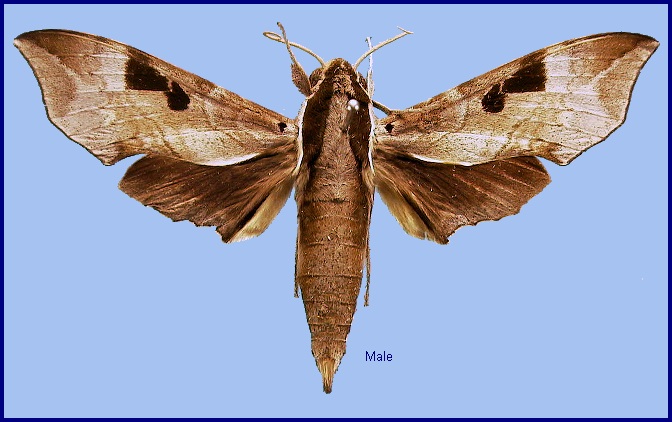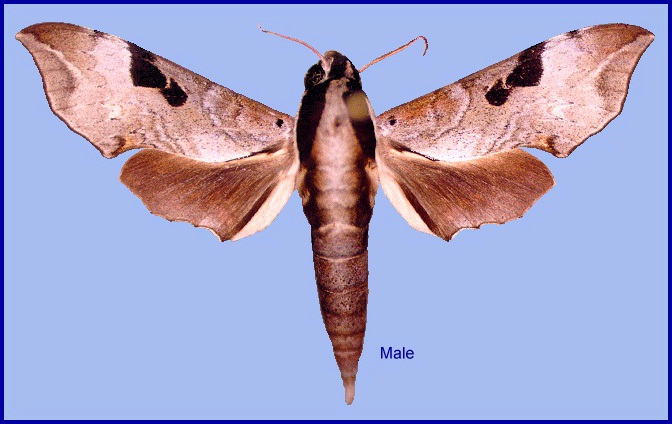


Angonyx borneensis Butler, 1879, Trans. ent. Soc. Lond. 1879: 261. Type locality: Borneo.
Synonym. Angonyx borneensis Butler, 1879.
Synonym. Daphnis labuana Rothschild, 1895.
Strongly sexually dimorphic. In the male, forewing outer margin smoothly curved, not scalloped posterior to M3 as in Enpinanga assamensis and Enpinanga vigens. Forewing upperside ground colour pale grey; discal spot with a rounded dark broad spot basad of it and a rectangular dark brown spot distad of it running from M3 to the costa, a slightly transparent cream spot on the postmedian line between Cu1 and Cu2. Forewing underside paler than in Enpinanga assamensis or Enpinanga vigens, lacking red areas proximal to the ragged submarginal line. Hindwing upperside almost uniformly dark brown, buff median band barely visible in tornal third of wing.
In the female, forewing upperside ground colour greyish brown; median line diffuse, dark brown; submarginal line serrate, edged in dark orange brown, which colour expands near the costa to fill the triangle between the submarginal line, costa and the apical stripe; discal spot inconspicuous or absent. Hindwing upperside with a distinctive broad, straw coloured, inner margin, as in the male.
In the male genitalia, uncus twice length of gnathos, more strongly curved apically than in Enpinanga vigens. Gnathos less clearly sinuate than in Enpinanga vigens. Valve with a row of stridulatory scales. Harpe very short, obliquely truncate but individually variable. Phallus process short, extends basally as a ridge along the phallus, with numerous apical teeth.





OVUM:
LARVA: Full-fed 75--80mm long. The final instar larva of Enpinanga borneensis is similar to that of Enpinanga vigens, as both share an overall green body colour (Leong, 2008). However, the pair of dorsal stripes in Enpinanga borneensis is less distinct and rather faint. For Enpinanga borneensis, there is also a ventrolateral expansion at the T3/A1 segments, but this is less pronounced than in Enpinanga vigens. This anterior flange has an orange margin, with a 'burnt' black spot anterior to the spiracle at A1 for Enpinanga borneensis, but not so for Enpinanga vigens. Along the rim of this ventrolateral expansion there is a row of small, white granules between T2 and the anterior half of A1, but these are not as closely arranged or as large as in Enpinanga vigens (Leong & D'Rozario, 2014).





PUPA:

Larval hostplants. Dillenia and Tetracera (Dilleniaceae) (Inoue, Kennett & Kitching, [1996] 1997). In Singapore mainly on Dillenia suffruticosa (Leong, T. M., 2008).



China: ?Yunnan (Shuanghui).
Thailand, Vietnam (Le & Vu, 2024), Malaysia (Peninsular, Sarawak), Indonesia (Sumatra, Java, Kalimantan), and the Philippines (Palawan).

 Return to Sphingidae of the Eastern Palaearctic species list
Return to Sphingidae of the Eastern Palaearctic species list